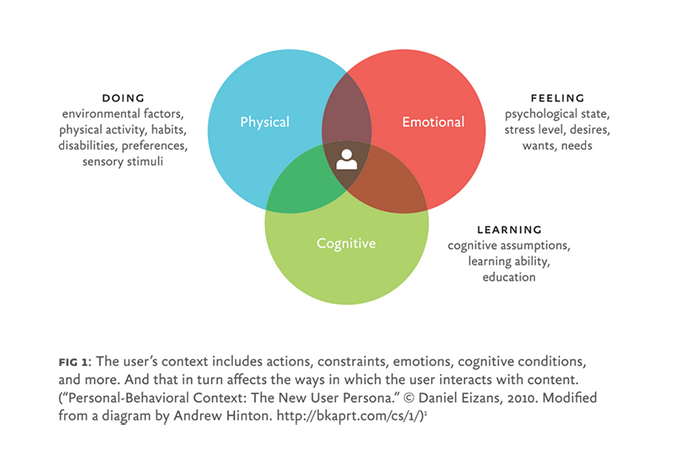By 2011, when Erin published her work, there had been a whirlwind of invaluable books and articles released by pioneers in the field of content strategy. The 2007 post by Rachel Lovinger, “Content Strategy: The Philosophy of Data” (Lovinger, 2007), reverberated through the still-forming community of content strategists, who hadn’t yet fully embraced that job title. One year later, the most commonly referenced definition of content strategy was penned by a prominent content strategist, Kristina Halvorson, on the virtual pages of A List Apart (Halvorson, 2008). Halvorson followed up with her book, Content Strategy for the Web in 2009 (which was renewed in 2012 – you can read our literature review of that book here) to drive the point home – content strategy was the much-needed answer to the plague of hastily produced web content that missed the mark when it came to audience needs and had no clear goals .
Erin's book added another piece of the puzzle and a picture of how to execute a content strategy step by step began to emerge. Her work is a call to action to continue making content strategy a sought-after area of expertise. In Kristina Halvorson’s words, the book is the “torch for content strategy” (Kissane, 2011).
Foreword by Kristina Halvorson, author of Content Strategy for the Web Introduction Chapter 1: Basic Principles Chapter 2: The Craft of Content Strategy Chapter 3: Tools and Techniques In Conclusion |
Table 1. Table of contents of The Elements of Content Strategy by Erin Kissane
Defining Good Content
The first chapter of the book takes on the task of defining what content strategists understand by “good content”. The answer, while not straightforward because good content strategy does not employ the cookie-cutter approach, paints a framework of a process that helps companies arrive at their subjective definition of content.
Because good content is relative, its value is determined by how well the businesses understand what is right for them, their users, and the domain in which they operate. In this sense, a content strategy is a tool for clarifying these questions and reaching that sweet spot.
Erin uses the adjective “appropriate” when describing content that is right for the target audience. Content should be appropriate in the method of delivery, style, format, and context. The latter goes beyond user goals, which while valuable might not accurately portray how customers engage with content. A deep dive into user mental models and behaviours can provide a meaningful analysis of user context that will vary: from the type of device used to access information, to ambiguous variables such as feeling or stress level.

Erin goes on to explain that one of the common traps of companies creating content on the web is creating one-directional communication channels filled with purposeless, self-absorbed content.
Each piece of content is an investment of time and resources – it’s too valuable of an opportunity to let content out in the wild without giving it a clear purpose. It also needs to be able to engage users in conversation, which can only be achieved if said content fulfils the requirements of user-centricity. What’s more, purpose defines the content lifecycle – from how it’s delivered, how often, and on what channels, to for how long.
It’s important for anyone involved in the process of creating content to understand that defining the why of content is only part of the process. Once the legwork of clarifying the user and business needs is done and the path towards usefulness has been charted, Erin advises to remember the logistics of content delivery.
Clarity – be it in terms of language, information architecture, or UX – not only benefits the content recipients but also the teams working on the content infrastructures.
Consistency is another element of an effective content strategy – speak to your audience in one voice, and continue your conversation with them rather than starting anew at each touchpoint. The author assures us that consistency is not a straitjacket – there is room for creativity, especially when we serve multiple audiences under the umbrella of one brand.
“For most people, language is our primary interface with each other and with the external world. Consistency of language and presentation acts as a consistent interface, reducing the users’ cognitive load and making it easier for readers to understand what they read. Inconsistency, on the other hand, adds cognitive effort, hinders understanding, and distracts readers.”
Finally, the first part wraps up with advice on one of the most common downfalls of content production – creating too much content that dies a slow painful death of irrelevance. There is a general tendency to believe that when it comes to content, more is more. Unfortunately, this leads to pages of content nobody asked for. Examples include press releases, redundant documentation, or endless feature lists. Such content is needless and very likely created in a resource-hungry sprint when publishing something was more important than delivering value. Similarly, content that is allowed to go a long time without upkeep is a wasted opportunity. What was once interesting, decayed quickly because of new reports being published or the user context changing rapidly. The advice here is to be ruthless – either eliminate content that does not serve the company anymore or make a robust content support plan.
The Role of Content Strategist in a Project
The second part of the book is almost like a pat on the back of every self-doubting content strategist out there. Wherever you are coming from, be it marketing, copywriting, or content management, content strategy is eagerly awaiting your contribution.
In Erin’s words, content strategy is “the planning and leadership of content projects and online publishing endeavours” (Kissane, 2011, p. 14) which points towards the unique position of the discipline in the context of business strategy. It’s as much about anticipating risks as it is about leading content work.
Essentially, being a content strategist entails relationship management and opening communication channels between different departments to bring the content strategy plan into a happy reality. It very much stems from the rich background of content strategy – a discipline born out of conversations between UX, information architecture, content management, technical writing, user research and so on (Halvorson, 2008). It was created because the unique skillset was needed to bridge these fields that need to come together to create good, user-centric content.
The author explores the four most influential fields in the DNA of content strategy: editorial work, curatorial work, marketing and persuasion, and information science. A content strategist has to understand the workings of publishing practice from concept to delivery and be able to guide others in telling a story. They have to manage resources and get stakeholder buy-in to set the organizational change into motion. It’s about getting a feel for the field with its intricacies and about accommodating users. Finally, content strategy is about making compelling arguments for how to deliver content to users, what technology is needed to make that happen, and how to measure content success.
“To do our jobs well, we must balance an understanding of the context in which content is created (sourcing, business goals, workflow) with an understanding of the context in which it is read and used (user needs, delivery channels). And immersion in both worlds is what makes the right balance possible.”
Through the exploration of commonalities between content strategy and each of these areas, Erin invites the readers to find the direction within the role of content strategists about which they are most excited. This versatility is arguably one of the biggest advantages of content strategy – it’s a field that adopts “the best of” from adjacent industries in service of business and customer goals. At the same time, understanding the processes and priorities for each of the four fields is the necessary cross-training. Knowing enough about other disciplines is essential to being able to ask the right questions at the right time to successfully deliver a content strategy.
Side note: you might want to take a look at our literature review of The Language of Content Strategy by Rahel Anne Bailie and Scott Abel – a lexicon of 52 terms that are central to the discipline of content strategy and represent the different fields that influence it.
The Content Strategist’s Toolkit
The third part of the book is where theory ends and practice begins. As mentioned, content strategy draws from different disciplines, hence the list of tools commonly used in different phases of the content strategy project is quite vast.
Depending on your background, you might focus on a very narrow area of content strategy. You might choose to develop into a front-end or back-end content strategist (Rockley, 2016). Wherever your path takes you, you need a methodology that supports your work. Erin shares her own methodology as an example, which she developed based on her background as an online editorial strategist, who usually works with user experience and web development – Evaluate, Design, and Execute. But there isn’t any absolute methodology that one should adopt blindly – it all comes down to your experience and work style, as well as the areas you wish to focus on.
Before the author dives into the specifics of different tools, she includes a couple of sections about understanding the audience in each project. It cannot be said enough that project teams are their own type of audience – the audience for deliverables. Each project will call for deliverables, the tangible outcomes of hours or work. Hence, before the project work starts, it’s essential to map out what the internal recipients of the project will receive. The guidance here is to choose one of the tried and tested deliverables groupings: by phase (When does the deliverable happen?), by function (What does the deliverable do?), by method (How does the deliverable work?), or by audience (Who is the deliverable for?).
The following sections in the book dig deeper into the specifics of the content strategy projects: from research and assessment; to strategy and design, planning for content creation, and content management. Erin explains in painstaking detail the ins and outs of how to implement a content strategy to achieve the perfect balance of customer and business goals described in the first chapter. From the practical perspective to the useful tips on conquering large projects with smart delegating – Erin poured years of experience into these pages to address any potential worry. It’s not an easy route, but the broad overview of the available tools and techniques, combined with the constant reassurance of the flexibility of the ever-evolving content strategy, empowers the reader to go out and put theory into practice.
“When I get stuck on a project or intimidated by a blank page, there are a handful of books I reach for to remind myself what my options are: what else to try, what criteria I should use to judge my work, and how I might think differently about the obstacles ahead. If this book can be such a reference for some of you, I’ll consider it a great success. Onward.”
Where to go from here #
References #
A List Apart. (2008, August 9). A List Apart—About. A List Apart. https://alistapart.com/about/
Bailie, R. A. (2021, September 2). An uneven history of content strategy. Medium. https://rahelab.medium.com/an-uneven-history-of-content-strategy-d514cfd7eee5
Erin Kissane (@[email protected]). (2023, December 6). Mas.To. https://mas.to/@kissane
Halvorson, K. (2008, December 16). The Discipline of Content Strategy. A List Apart. https://alistapart.com/article/thedisciplineofcontentstrategy/
Kissane, E. (2011). The Elements of Content Strategy (1st edition). A Book Apart.
Lovinger, R. (2007, March 27). Content Strategy: The Philosophy of Data. Boxes and Arrows. https://boxesandarrows.com/content-strategy-the-philosophy-of-data/
Rockley, A. (2016). Why You Need Two Types of Content Strategist. Content Marketing Institute. https://contentmarketinginstitute.com/articles/types-content-strategist/

